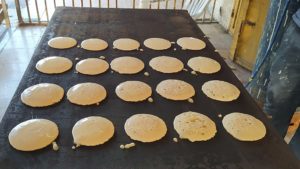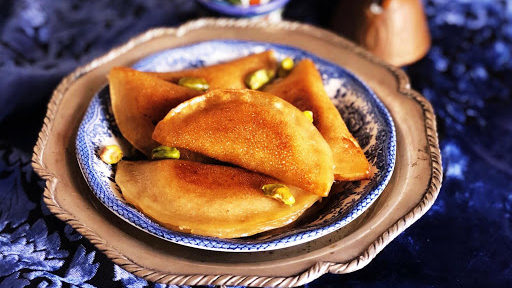Palestinian Chef Brings ‘Italian Twist’ to Traditional Ramadan Recipe
Trained in Padua, Fidaa Abuhamdiya combines culinary heritages to create delicious dishes
During the holy month of Ramadan, Muslims the world over pray, reflect and get together with their families, in addition to fasting from sunrise to sunset.
Abstaining from food during Ramadan, which begins on April 13 and is slated to end on May 12, can at times be quite daunting, especially during the longer and hotter days. For this reason, many of the hallmark dishes that are eaten following a day of fasting during this period are quite filling and nutritious, including qatayef, a sweet dumpling that is commonly served during the holy month. Muslims often enjoy a few pieces of the delectable dessert following their fast-breaking meal, known as iftar.
Palestinian chef Fidaa Abuhamdiya has taken the traditional qatayef dish and given it a creative Italian twist.
Born in Hebron in 1982, Abuhamdiya pursued her culinary and gastronomic studies at the University of Padua in Italy.
Though she currently resides in the Palestinian West Bank city of Ramallah, most of her recipes are written in Italian, a language to which she has long been attracted. Abuhamdiya’s unique perspective on food culture also has led to the creation of Italian-Palestinian fusion cuisine.
On one hand, she makes her own tiramisu, panettone and other mouthwatering Italian goodies that she sells to Palestinians via a project she refers to as Tiramix Palestine; on the other, she publicizes her own Palestinian heritage on Italian websites and via a cookbook published in 2016 that she co-authored with Italian chef Silvia Chiarantini called “Pop Palestine Cuisine.” The book features over 60 recipes.
Abuhamdiya spoke to The Media Line about her experiences as a chef and also shared one of her most popular Ramadan recipes.
TML: How does your cuisine combine Palestinian and Italian culinary traditions?
ABUHAMDIYA: At home I cook both Palestinian and Italian. Some recipes are fusion but my home is Italian and Palestinian.
It’s not hard [to mix them] because we are very close to the Italian food culture in the south of Italy. It’s not really hard to adapt the taste [of] these new dishes because we almost have the same ingredients: olive oil, durum wheat and meat. These are the three main things that [the food] is based upon.
For example, sometimes I make ravioli with cheese and fresh Palestinian za’atar and it’s very delicious.
TML: How well-known is your food in both Italy and Palestine?
ABUHAMDIYA: In Italy, I’m well known as a Palestinian chef with Palestinian food; in Palestine I’m known for Italian food. When people here talk about Italian food, many people think about me, fortunately.
TML: How did you get into cooking when you were younger? What made you decide to go in that direction?
ABUHAMDIYA: I was born with this love of cooking, eating and food culture. I consider food as a tool of communication. For me, it was about cooking for people and not just about giving them recipes.
It’s like studying any other thing and you [can] teach others. Sometimes I even teach at a school here and most of the young students choose culinary school because they’re not good at other [subjects] or because they have problems.
But food doesn’t have to be a last choice. I could’ve chosen other things but I chose this because I’m happy to work in this sector.
TML: What attracted you to Italian culture and cuisine?
ABUHAMDIYA: I was attracted to the language at first, and then the culture and the food.
TML: Why do you think Ramadan is important, in terms of food?
ABUHAMDIYA: People are seeing each other and gathering together. Usually, people work and even those in the same family don’t have the time to sit down to have dinner or lunch together. So, Ramadan is an occasion for all people to come together.
People who celebrate Ramadan sit together and eat together, even those that don’t observe it.
I don’t like that Ramadan has become commercial and that people hurry to buy food and things like that. I’m not against special recipes and desserts for Ramadan, but I’m against the ‘too much’ of things: buying too [much] and serving too many foods.
TML: What are some of the special foods that people eat during Ramadan?
ABUHAMDIYA: There are many hours of fasting. Arabic salad with tahini is very important during Ramadan. Also, people start Ramadan with eating dates.
There are also many types of juices that you don’t see outside of Ramadan, like tamarind, lemon or almond juice.
There is also qatayef, a special sweet for Ramadan that is a kind of pancake filled with nuts or cheese. I love it.
TML: What is your vision for the future and what do you hope will be the impact of your cooking?
ABUHAMDIYA: I hope my cooking will arrive in every home! For Palestinian culture, I speak and write in Italian so I know that my Palestinian food will be in many Italian households. They’ve invited me into their houses and it’s really nice.

Qatayef pancakes are prepared on a hot griddle. (Wikimedia Commons)
Fidaa Abuhamdiya’s Qatayef Recipe (from Fidafood.blogspot.com)
Ingredients:
For the dough:
2 cups Italian-type “0” flour (or all-purpose flour)
¼ cup durum wheat flour
3 cups lukewarm water
1 tsp baking powder
2 tbsp sugar
For the filling:
400 g of Tosella Italian cheese (soft white cheese, can be substituted with Akkawi cheese)
1 tsp cinnamon
2 tbsp sugar
Instructions for the dough:
- Place all the dough ingredients in a bowl and whisk until a batter is formed.
- Place non-stick frying pan over heat, wait until the pan is hot and then, using a ladle, pour the batter into circular shapes that are more or less 15 cm (just under 6 inches) in diameter.
- The pancakes are cooked on one side only, so within a few minutes they can be removed from the heat and set aside on a plate.
Instructions for the filling:
- Crumble the soft cheese with your hands into a bowl.
- Add cinnamon, sugar and mix all together.
- Place a spoonful of filling in each Qatayef pancake and close to form a crescent shape. Press down edges with your hands.
Cooking and serving instructions:
For baked Qatayef:
- Preheat oven to 180 degrees Celsius (360 F).
- Arrange the turnovers on a baking pan lined with parchment paper and brush them with butter.
- Bake for roughly 10 minutes or until the turnovers are golden in color.
- Serve with honey on top.
For fried Qatayef:
- Fry the Qatayef in a non-stick pan with vegetable oil until golden.
- Serve with honey on top.


